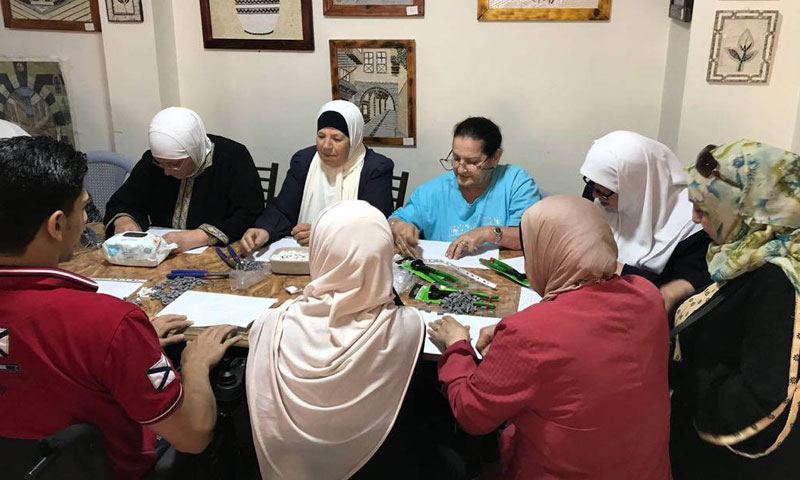



“Mosaic” or “stone mosaic,” the name does not matter as much as the interest lately given to this craft and teaching it by the civil society organizations inside Syria and abroad.
The organizations’ activities varied between conducting training courses as to teach the basics of the mosaic art and launching exhibitions and centers specialized in this field, all of which concentrated on the empowerment of the vulnerable classes of the Syrian society and the refugee communities.
The “Souriyat Across Borders” (Syrian Women Across Borders) Organization has conducted a training workshop at the Jordanian capital city, Amman, as to teach participants the skills of the “stone mosaic” industry, in the period from 14 to 17 of October, targeting Syrian older persons.
Obada al-Asimi, Official of the Training and Habilitation Programs at the “Souriyat Across Borders” organization, told Enab Baladi that 20 Syrian older persons have benefited from the workshop, pointing out that it has included theoretical and practical illustrations of the “mosaic” art, ending with an honoring ceremony, during which participants were awarded in respect of the artistic pieces they produced during the training course.
Al-Asemi stressed the necessity for the Syrian civil society organizations to keep older people in mind and called for conducting activities that help them rid of life’s pressure, increase their confidence and ability at production.
The training workshop was organized with the support of the “Leave No One Behind” Program of the HelpAge International, specialized in enhancing socialization and integration at all age stages.
One of the “mosaic” training workshop’s women beneficiaries, Muna Sukaryah, told the Jordan News Agency (Petra) that she experienced an overwhelming joy and an increasing self-confidence when she turned stones into an artistic piece that “satisfy the eyes.”
The “Souriyat Across Borders” organization organized a similar workshop last May, targeting Syrian people with disabilities in Jordan, as to offer the trainees a craft that would help them make an income and integrate into society, in addition to raising people’s awareness of this important traditional craft.
The organization also organized an exhibition, where the “mosaic” works of art, made by people with disability of the workshop’s trainees were showcased.
The pieces are decided to soon be presented at a U.S. based exhibition, according to what Iyad Ayoubi, the Media and Education official at the “Souriyat Across Borders” organization, has told Enab Baladi.
Interest in the “mosaic” art was not limited to the Syrian refugee community, but it also has been active inside Syria, for the city of Kafr Nabl, rural Idlib, witnessed the opening of a specialized training center, which addresses Syrian women, both widows and detainees’ wives.
The “Ghazal” Center, opened last August, has launched its first training course, which included 30 women breadwinners. The Center aims to help the beneficiaries make a fixed income, in addition to the preservation of this art by introducing it to younger generations and women, for this craft has been monopolized by Syrian men to a certain extent.
It is decided that the women trainees work in the field of “mosaic” making, within small home-based projects, capable of providing them with a monthly income, according to what the Director of the “Ghazal” Center Ahmad al-Dani has told Enab Baladi in a former interview, pointing out that this craft does not require costly tools, and it only demands buying the stones, which are already available at Kafr Nabl, in addition to the manual stone cutting tool.
Mosaic is an ancient Syrian art that is more than 300 years deep in Damascus’ history; it is the art of grafting wood with shells, silver or ivory. Early in the 19th century, mosaic existed in the houses of almost all well-established Syrian families, after which it became a familiar décor in presidential palaces around the world.
The art of “Mosaic” is equally famous in Idlib governorate, in the city of Kafr Nabl in particular, considered one of the key sources of its production and marketing within Arab states.
if you think the article contain wrong information or you have additional details Send Correction